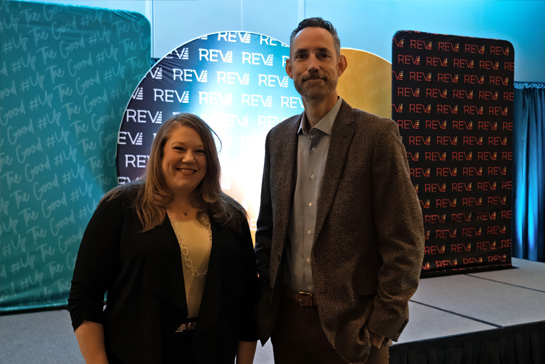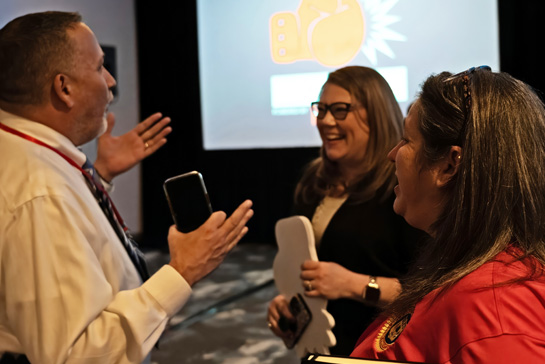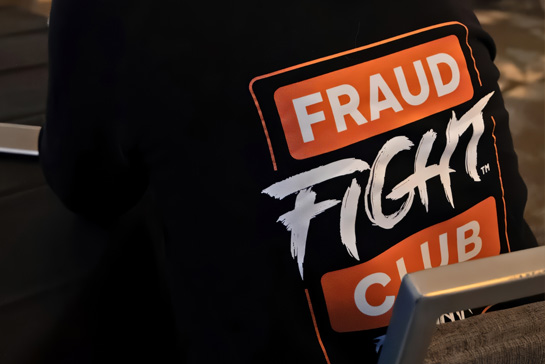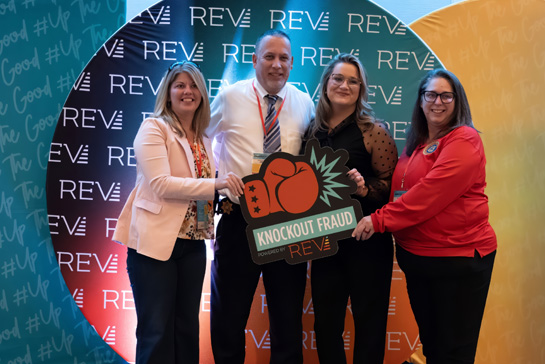Fraud Summit Recap: Cross Sector Strategies to Detect, Deter and Respond
With fraud tactics evolving faster than ever, REV convened its fourth annual Knockout Fraud Summit on Friday, Oct. 24. The daylong forum drew law enforcement, nonprofits, financial institutions and federal partners — including the U.S. Secret Service and the Department of Defense Office of Inspector General — to examine emerging schemes and share practical defenses.
Subject-matter experts led focused sessions on business fraud prevention, social-engineering and cyberfraud, and ways to close critical gaps in member and community response. What follows are summaries of each presentation, highlighting the tactics discussed, the tools recommended and the action steps organizations can take right now to stay ahead of threat actors.
Knockout Fraud: Turning Social Media into a Force for Good
Shelley Youngblood, Director of Brand Marketing, REV Federal Credit Union
Youngblood contended that social media, now a primary origin point for online fraud, can be repurposed as a frontline tool for prevention, education and trust building. Nearly half of online fraud begins on social platforms, with Facebook and Instagram cited as leading entry points, and scammers commonly impersonate brands, post fake ads and use direct messages to pose as customer support. Because social content is real time, visual and human, it is well suited to counter those tactics when messages are crafted for how people actually consume content.
Practical guidance centered on clarity, consistency and audience fit: make fraud awareness posts short (about 20 seconds or less), visual (icons, photos or brief video), plain language (not compliance jargon) and helpful (end with one clear action such as “pause before you click”). Avoid fear driven messaging that induces tune out; favor calm, empowering language that shifts readers from panic to partnership. Start small: pick one or two platforms where target audiences already engage, establish a predictable cadence (for example, a weekly tip or alert), and align marketing and fraud teams so visuals and technical guidance match. Simple tools and ready templates (Adobe Express, Canva, Microsoft Designer) can accelerate execution, and a steady stream of useful posts amplifies protection: educating one person can protect many.

Shelley Youngblood
Director of Brand Marketing,
REV Federal Credit Union
Knockout Fraud: The Heart of a Fraud Fighter
Ian Mitchell, Founder and Board Chair, The Knoble
Rather than a narrow payments problem, fraud was described as a societal harm that funnels generational assets into organized crime. A personal anecdote — a targeted Canadian pension account scam that cost a family member $5,000 — illustrated how even cautious, informed people are vulnerable. Human trafficking and child targeted scams were singled out for their severe human cost, with the United Nations estimate of nearly 50 million people affected by modern slavery cited to underline the scale where financial exploitation and trafficking intersect. The core point: these crimes are economically motivated and leave clear money trails, so stopping transactions is necessary but not sufficient; the response must center on the people harmed.
Practical and moral imperatives were paired with a call to community action. Fraud was described as an organized, profit driven business model that moves money upward through networks, which makes recovery and deterrence dependent on coordinated investigation, reporting and cross sector partnerships. Mitchell closed on a note of resilience, noting more than 660,000 practitioners who work in fraud prevention and a volunteer network of roughly 2,300 Knoble members who contribute time and expertise, and urged the field to invest more resources in combating exploitation so prevention keeps pace with the harms.

Ian Mitchell
Founder and Board Chair,
The Knoble
Knockout Fraud: The Fraud Horizon: Anticipating Tomorrow’s Threats, Protecting Today’s Customers
Tim Chambers, Chief Operating Officer, Mission Omega
Opening with a 2025 cost frame, the speaker said institutions now incur roughly $5.00–$5.75 in total costs for every $1 of fraud loss, including recovery, operations and fines; business email compromise, deep fake and social engineering attacks were cited as key drivers, with 79% of organizations reporting payments incidents in 2024 and wire/ACH losses totaling $2.9 billion that year. Emerging vectors include deep fake KYC video attacks, AI voice clone call center takeovers, credential stuffing against open banking APIs, FedNow/RTP mule swarms and renewed ATM “jackpotting.” In 2024 about 22% of organizations recouped roughly 75% of stolen funds, underscoring the limits of recovery and the urgency of prevention.
Recommendations were tailored by institution size. Small and mid sized institutions were urged to tighten P2P and RDC controls, deploy behavioral analytics, strengthen vendor onboarding and traditional authentication, and prioritize staff and member awareness, while large institutions should invest in AI driven behavioral and biometric analytics, expand predictive modeling, orchestration and model governance, and integrate cross border intelligence. For high risk attacks, Chambers recommended requiring active liveness, binding device biometrics and risk weighting new to bank accounts for 90 days to counter deep fake KYC; using challenge phrase MFA, phonetic analysis and shortened IVR reset windows against AI voice clones; and accelerating controls and intelligence sharing on instant payment rails to disrupt mule activity before losses crystallize.

Tim Chambers
Chief Operating Officer,
Mission Omega
Knockout Fraud: Connecting The Dots: Social Engineering and Cybercrimes
Marc Evans, Founder, Fraud Hero
Evans positioned social engineering as the principal vector for contemporary cybercrime, noting that attackers bypass hardened systems by exploiting human behavior—trust, fear and urgency—rather than technical vulnerabilities. Social engineering now initiates roughly 90% of cyberattacks, and conventional security tools offer limited protection because the threat targets people, not machines. Typical ploys include law enforcement and government imposters, bank and investment fraud, romance schemes, tech support cons and cryptocurrency scams. To underscore the scale, FBI figures for 2024 were cited: more than $16 billion lost nationwide, $9.3 billion tied to crypto, and $4.8 billion lost by people 60 and older. The growing supply of target data—1,732 reported breaches in the first half of 2025, ongoing insider theft and readily available personal information from data brokers—was identified as the fueling factor behind increasingly convincing approaches; losses tied to crypto ATMs ($246 million) were highlighted alongside the expanding ATM footprint in some states. The U.S. has about 31,000 crypto ATMs; Canada about 3,000. South Carolina is home to roughly 570 crypto ATMs.
Fraud is not primarily a technical failing but a human one, and the best defenses are continuous awareness, education and rapid, evidence based response. Attack sequences typically begin with harvested or brokered data, followed by tailored outreach that leverages psychological levers; investigations therefore must prioritize reconstructing timelines, preserving communications and transaction records, and tracing payment flows or wallet addresses in crypto cases. The prescription is straightforward: treat people as both the vulnerability and the first line of defense by investing in ongoing education, timely threat intelligence sharing and clear reporting and remediation protocols so incidents do not fall through the cracks.

Marc Evans
Founder,
Fraud Hero
Knockout Fraud: Designing Fraud Programs for Small but Mighty Teams
Hailey Windham, Founder, CU Fight Fraud, LLC
Windham delivered a pragmatic playbook for financial institutions with limited staff and budgets, arguing that fraud prevention must begin before losses force investment. Core challenges were clear: limited bandwidth without a dedicated fraud role, alert overload that outpaces investigative capacity, constrained budgets, and leadership pressure to “do more with less.” Those pressures often leave fraud an afterthought until a material loss prompts urgent questions about root cause and remediation.
The recommended framework centers on three pillars: people, process and technology. People: cross train staff, empower frontline “fraud ambassadors,” and recruit volunteers across departments to surface behavioral red flags systems miss. Process: codify repeatable playbooks, use a simple internal referral form for unusual activity, close the loop on every referral, and hold monthly huddles to share trends and improve member care. Technology: optimize existing systems and tune detection queues before buying new tools. Reporting should emphasize prevention and recoveries with concise visuals and clear trends rather than focusing only on losses. Partnerships with law enforcement, peer credit unions and vendors were presented as force multipliers for recoveries, intelligence sharing and scalable capabilities. A 30/60/90 plan — audit current state (30), build and refine playbooks and detection (60), and formalize metrics, celebrate wins and launch an ambassador network (90) — rounded out the guidance: start where you are, use what you have, and prioritize clarity, consistency and member protection.

Hailey Windham
Founder,
CU Fight Fraud, LLC
Knockout Fraud: Fraud-Gotcha: Occupational Fraud
Ramona Farrell, Founder, Farrell Insights, LLC
Windham delivered a pragmatic playbook for financial institutions with limited staff and budgets, arguing that fraud prevention must begin before losses force investment. Core challenges were clear: limited bandwidth without a dedicated fraud role, alert overload that outpaces investigative capacity, constrained budgets, and leadership pressure to “do more with less.” Those pressures often leave fraud an afterthought until a material loss prompts urgent questions about root cause and remediation.
The recommended framework centers on three pillars: people, process and technology. People: cross train staff, empower frontline “fraud ambassadors,” and recruit volunteers across departments to surface behavioral red flags systems miss. Process: codify repeatable playbooks, use a simple internal referral form for unusual activity, close the loop on every referral, and hold monthly huddles to share trends and improve member care. Technology: optimize existing systems and tune detection queues before buying new tools. Reporting should emphasize prevention and recoveries with concise visuals and clear trends rather than focusing only on losses. Partnerships with law enforcement, peer credit unions and vendors were presented as force multipliers for recoveries, intelligence sharing and scalable capabilities. A 30/60/90 plan — audit current state (30), build and refine playbooks and detection (60), and formalize metrics, celebrate wins and launch an ambassador network (90) — rounded out the guidance: start where you are, use what you have, and prioritize clarity, consistency and member protection.

Ramona Farrell
Founder,
Farrell Insights, LLC
Knockout Fraud is open to law enforcement agencies and organizational representatives only. To be notified about next year’s event, contact Marketing@REVfcu.com.








